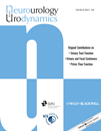On the anatomy and histology of the pubovisceral muscle enthesis in women†‡ §
Dirk De Ridder led the review process.
Conflicts of interest: Dr. DeLancey and Dr. Ashton-Miller are consultants for American Medical Systems and Johnson & Johnson. They also receive research grants from American Medical Systems and Kimberly-Clark. The other authors have no disclosures to report.
This study was presented at the 31st American Urogynecologic Society Annual Scientific Meeting, Long Beach, California, USA, September 2010.
Abstract
Aims
The origin of the pubovisceral muscle (PVM) from the pubic bone is known to be at elevated risk for injury during difficult vaginal births. We examined the anatomy and histology of its enthesial origin to classify its type and see if it differs from appendicular entheses.
Methods
Parasagittal sections of the pubic bone, PVM enthesis, myotendinous junction, and muscle proper were harvested from five female cadavers (51–98 years). Histological sections were prepared with hematoxylin and eosin, Masson's trichrome, and Verhoeff-Van Gieson stains. The type of enthesis was identified according to a published enthesial classification scheme. Quantitative imaging analysis was performed in sampling bands 2 mm apart along the enthesis to determine its cross-sectional area and composition.
Results
The PVM enthesis can be classified as a fibrous enthesis. The PVM muscle fibers terminated in collagenous fibers that insert tangentially onto the periosteum of the pubic bone for the most part. Sharpey's fibers were not observed. In a longitudinal cross-section, the area of the connective tissue and muscle becomes equal approximately 8 mm from the pubic bone.
Conclusion
The PVM originates bilaterally from the pubic bone via fibrous entheses whose collagen fibers arise tangentially from the periosteum of the pubic bone. Neurourol. Urodynam. 30:1366–1370, 2011. © 2010 Wiley-Liss, Inc.




